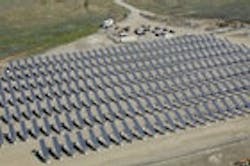Metropolitan Water District of Southern California Activates Solar Panels at Treatment Plant
With a flip of a switch, the Metropolitan Water District of Southern California recently added to its investments in solar power.
Metropolitan Board Chairman Timothy F. Brick flipped a switch signifying activation of a 10-acre field of solar panels at the district’s Robert A. Skinner Water Treatment Plant in the Temecula Valley of southwestern Riverside County.
The 1-megawatt solar installation will generate about 2.4 million kilowatt-hours (kWh) of clean, renewable energy a year, nearly 25% of the power used by the plant and equal to the power used by about 250 homes annually. The produced energy will be used directly at the plant, helping to offset nearly 2 million lb of carbon emissions a year. Last year, the plant consumed about 10.5 million kWh of electricity, at a cost of nearly $1.2 million.
“As public stewards of our natural resources, Metropolitan is ever-conscious of the impact our operations have on the environment, from the delivery and treatment of water to the day-to-day operation of our facilities,” Brick said.
“Just as we have assumed a leadership role in promoting conservation and other waterwise activities such as recycling and groundwater cleanup, we are compelled to reduce our carbon footprint,” he said.
Debra C. Man, Metropolitan assistant general manager and chief operating officer, said generating solar power at the Skinner plant is part of a strategic power plan to be considered by Metropolitan’s board this summer. The proposed plan envisions Metropolitan having 10 megawatts of solar power installed throughout the district’s six-county service area over the next five years.
“The proposed plan will outline a number of energy-saving strategies at our facilities, while laying out immediate, short-term, intermediate and long-term goals,” Man said. “The plan’s goal will be to maximize carbon reduction at all our distribution facilities and develop renewable energy to support deliveries on the Colorado River Aqueduct.”
Skinner’s solar collection field features 462 sun-tracking stations, each supporting 10 230-watt panels. Each station of panels, weighing about 40 lb apiece, will generate about 5,000 kWh of electricity a year. The stations employ a tracking system that allows the panels to follow the sun’s path from east to west, producing 25% more power than fixed panels.
Man said the $10-million solar-generating facility is expected to pay for itself in six to eight years or sooner, as the solar generation facility would operate during peak demand periods when electricity costs are the highest. Metropolitan will receive more than $5 million in rebates from Southern California Edison during the first five years of operation.
Metropolitan’s program also is consistent with Gov. Arnold Schwarzenegger’s California Solar Initiative and state legislation, which have established a statewide goal to create 3,000 megawatts of new, solar-powered electricity by 2017, Man said.
Source: Metropolitan Water District of Southern California
